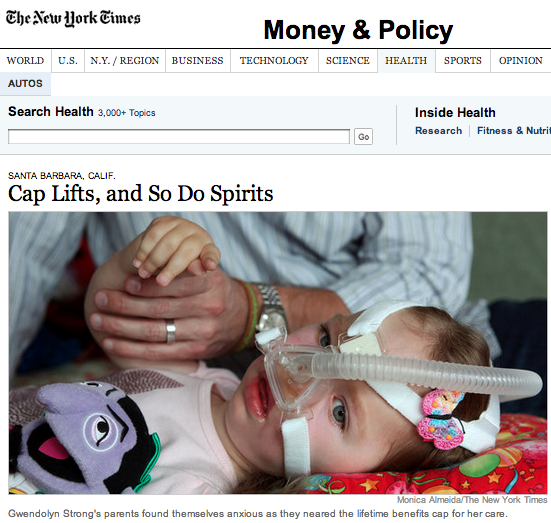
As a healthy couple in their mid-20s, Bill and Victoria Strong’s last concern when shopping for health insurance was a cap on lifetime benefits. Then Gwendolyn was born, and six months later was found to have spinal muscular atrophy Type I, a degenerative condition that typically kills its victims before age 2.
Suddenly, it became vital that their family policy, with Health Net of California, had a generous $5 million limit on benefits. With the help of hugely expensive care at their home in Santa Barbara, Calif. — ventilators, nebulizers, feeding tubes, suction machines — Gwendolyn has defied the odds to survive to nearly 3. And she has already consumed $2 million in care, about half of it from three hospitalizations in her first eight months.
“Anxiety was high,” said Mr. Strong, now 34, “because we were marching pretty quickly toward that $5 million cap. It was always in the back of my mind.”
Starting Thursday, the health care law prohibits lifetime caps, thereby extending coverage to the 20,400 people that the government estimates may exceed their limits each year. The law also begins to restrict annual limits on benefits, eliminating them fully in 2014.
For the Strongs, it means freedom from worry. “We know now that Gwendolyn will always have the quality of care that we promised her,” said Mr. Strong, the chief financial officer of an Internet venture company.
Although Gwendolyn’s body is withering, and she has lost most movement, the Strongs have learned to communicate with her through slight eye and finger motions. “Cognitively, she’s like any 3-year-old,” Mr. Strong said. “She loves princesses. She loves horses. She’s learning to count. She wants to learn her ABCs.”
When Mr. Strong joined his 20-person firm this year, he declined its offer of insurance because he knew that Gwendolyn’s costs would send its small group rates soaring. Instead, he maintained his individual family coverage, paying $6,000 a year in premiums for a policy with a steep $10,000 deductible. Gwendolyn’s uncovered medical expenses typically amount to an extra $20,000 to $30,000 a year.
The paradox was that each day of extended life for Gwendolyn brought the Strongs closer to the precipice. “I want my daughter to survive,” Mr. Strong said. “But nobody wants to have the threat of complete bankruptcy looming over their head. It’s just kind of inhumane the way the world works in these brutal situations.”



